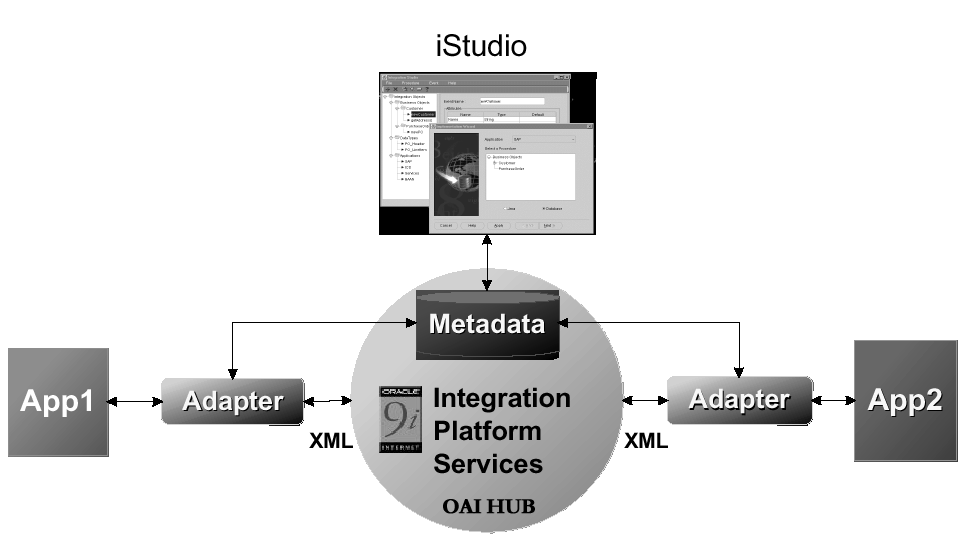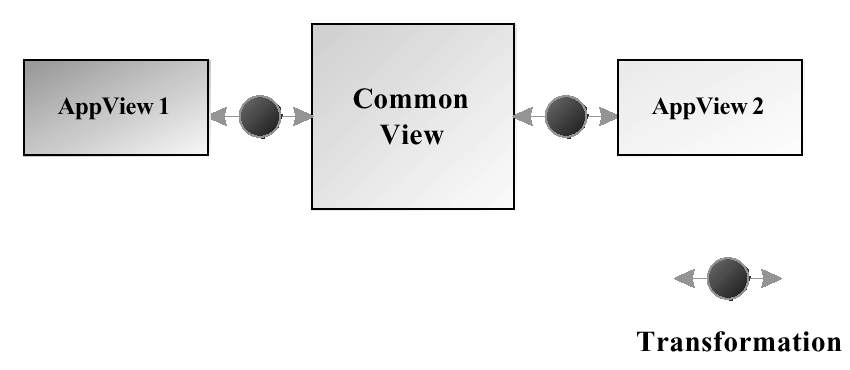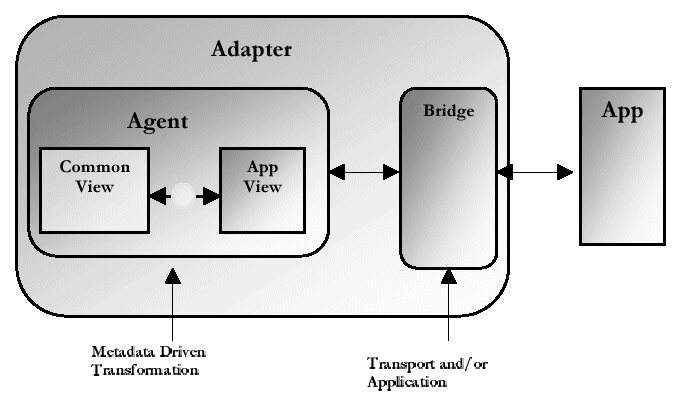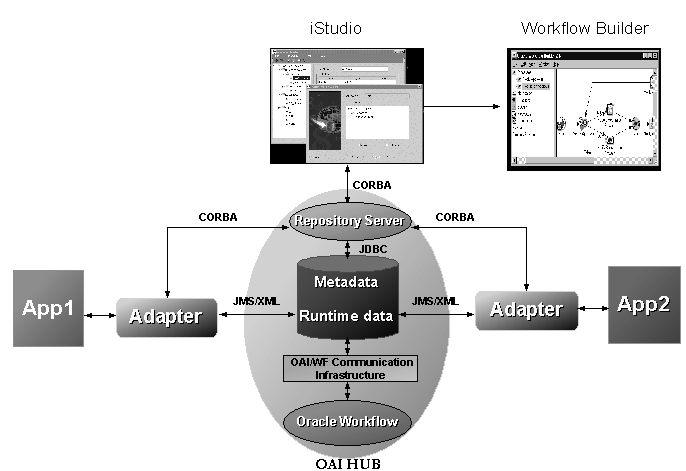Release 4.1
A90225-02
Library |
Solution Area |
Contents |
Index |
| Oracle Applications InterConnect User Guide Release 4.1 A90225-02 |
|
This chapter provides an overview of Oracle Applications InterConnect, its features, and components.
Topics include:
Oracle Applications InterConnect is the integration component of Oracle 9iAS and provides a comprehensive application integration framework to enable seamless integration of enterprise software. It is built on top of Oracle's robust integration platform and leverages its underlying services. It is designed to integrate heterogeneous systems, such as Oracle Applications, non-Oracle applications, or 3rd party messaging oriented middleware. This integration can be deployed either within an enterprise or across enterprise boundaries through the Internet.
The following are technical design goals for Oracle Applications InterConnect:
Oracle Applications InterConnect features include:
Oracle Applications InterConnect cleanly breaks up the integration problem into two discrete components:
Integration logic consists of the business rules and transformation logic necessary to integrate heterogeneous systems. Using iStudio, this integration logic can be modeled. The results are then stored in the Oracle Applications InterConnect repository as metadata.
Platform Services consist of the integration infrastructure provided with Oracle 9iAS and the Oracle database. In addition, Oracle Applications InterConnect provides application and protocol adapters. The platform services provide the requisite infrastructure necessary for integration.
Integration using Oracle Applications InterConnect is a two-step process. During design time, integration logic is modeled in iStudio and captured in the repository as metadata. At runtime, the underlying services treat this metadata as runtime instructions to enable the conversation among participating applications.

iStudio exposes an integration methodology that eliminates the complexities of point-to-point custom integration solutions. The integration methodology is based on a hub-and-spoke model.
An integration point is defined as an "event" that triggers communication between two or more participating applications in the integration scenario. The following are examples of such "events:"
App1 above, the customer should be created in App2 also. Therefore, "Create Customer" is an "event" that triggers the communication between the two applications--App1 produces the information, App2 consumes it.
App1 might request information on some item stored in App1. The information on that item might be segmented across the two applications. To give a meaningful response to the user of App1, it is necessary to query App2 for information on the item. Therefore, "Get Item Info" is an integration point between the two applications because it triggers communication between the two applications--App1 produces a query, App2 consumes it, App2 produces the response, and App1 consumes it.
The common view consists of a list of such integration points, each with its own associated data. Applications participate in the integration by binding to one or more of these common view integration points.
In the context of each binding, applications have their own application view of data that needs to be exchanged. Each binding involves mapping, or transformation, between the application view and the common view in the context of the integration point. In this model, the application views are at the spokes and the common view is the hub.
The Create Customer example helps to explain Figure 1-2, "Oracle Applications InterConnect Hub-and-Spoke Model". Create Customer is an integration point. If the information to exchange is the new customer's name only, then the common view has all the information potentially captured in a name defined in an application-independent way. In the very least, this information must be a superset of all the information that needs to be exchanged across App1 and App2.
Prefix, First Name, Last Name, Middle Initial, Maiden Name, Suffix is an example of a common view customer name definition.
Now, App1's internal "definition" of name (App1's application view) could be First Name, Last Name, Middle Initial, Prefix.
App2's application view could be Name (one field that contains Last Name, First Name).
For App1, in the context of sending this information out or publishing an event, transformations are defined from its application view to the common view. For App2, in the context of receiving this information or subscribing to an event, transformations are defined from the common view to its application view.

This hub-and-spoke model has the following advantages:
In the diagram below, App3 and App4 have been added to the integration scenario by plugging them into the common view. This does not affect the integration of App1 or App2.

Oracle Workflow provides a comprehensive business process management system that enables traditional workflow applications, as well as process collaboration in a single solution. Oracle Workflow's new Business Event System enables Oracle Applications InterConnect and Oracle Workflow to work together to provide a complete business process driven integration solution. With Oracle Applications InterConnect and Oracle Workflow, you can define business collaborations across two or more applications to implement the organization's business processes.
iStudio is a design time integration specification tool targeted at business analysts. This tool helps business analysts specify the integration logic at a functional level, not at a technical coding level. iStudio exposes the integration methodology using simple wizards and drastically reduces, even eliminates, the need for writing code to specify the integration logic. This reduces the total time required to complete an integration.
Considering iStudio is a multi-user tool with fine-grained locking for all Oracle Applications InterConnect first class objects, multiple users can work simultaneously on the same integration scenario without compromising the consistency of the metadata.
Managing, customizing, and evolving an integration over time is as important as creating the integration in the first place. The hub-and-spoke integration model has advantages to help achieve this goal. In addition, the Oracle Applications InterConnect repository, which contains all the integration logic, provides extensive services for managing changes over time. The repository provides fine-grained versioning of all Oracle Applications InterConnect first class objects such as events, messages, and data types. Some of the important aspects of versioning to help with the lifecycle support include the following:
All Oracle Applications InterConnect components are written in pure Java and utilize proven Oracle infrastructure to deliver a robust, reliable, and scalable integration solution. Oracle 9iAS and its corresponding database constitutes the messaging hub for Oracle Applications InterConnect. In particular, Oracle Workflow in Oracle 9iAS and Advanced Queues in the database allows an Oracle Applications InterConnect user to build integrations on top of a solid platform. Using Oracle Workflow, complex business processes can be built to handle different integration needs. In addition, Advanced Queues provide a robust messaging infrastructure, message retention, auditing, and tracking support.
Prepackaged adapters help re-purpose applications at runtime to participate in the integration without any programming effort.
Adapters are the run-time component for Oracle Applications InterConnect. Adpaters have the following responsibilities:

These adapters can be technology or application adapters. Oracle Applications InterConnect currently packages technology adapters for the Oracle database, Advanced Queues, and HTTP/S technology. Access to non-Oracle databases is possible through Transparent Gateways provided by Oracle. Application adapters include Oracle and SAP R/3 adapters.
Oracle Applications InterConnect is easily extended through SDKs which addresses custom integration needs. There are two SDKs to provide this flexibility:
Oracle Applications InterConnect provides all the basic services expected of a messaging middleware platform including:
The following value-added services are exposed through iStudio and do not require any coding:
Booked and Shipped. The corresponding field in a fulfillment system has the possible domain values 1 and 2. Oracle Applications InterConnect allows the user to create the mappings booked=1, shipped=2 so it can correlate these values at runtime without each system knowing the domain value set of the other system.
Oracle Applications InterConnect provides a complete framework for e-Business application integration across the Application-to-Application, Application Service Provider, and Business-to-Business domains. Oracle Applications InterConnect components can be deployed for all of these domains as described:
Oracle Applications InterConnect has the following core components.
iStudio is a graphical wizard-based design time tool. iStudio allows business analysts to complete the following tasks:
iStudio is deployed as a stand-alone Java application running outside the database. iStudio runs only on Windows NT and can be deployed anywhere with access to the hub machine.
The repository consists of a middle tier repository server program talking to a backend database. The following functionality is provided:
The repository server is deployed as a stand-alone Java application running outside the database. The repository schema is a set of tables in the backend database. Both the server and the database are on the hub machine.
Adapters are runtime components which process integration logic captured in the repository as runtime instructions to enable the integration. Adapters have two major tasks:
Adapters are deployed as stand-alone Java applications running outside the database. Adapters are physically co-located with the applications they connect to either on the same machine as the application itself, or on a separate machine. Adapters are usually not deployed on the hub machine.
The Runtime Management Console is an Oracle Enterprise Manager-based client/server combination. The Runtime Management Console provides the following functionality:
The Oracle Enterprise Manager console includes a server component usually installed on the hub machine. The client component can be installed on any machine where the integration environment is managed. Both client and server components are stand-alone Java applications running outside the database.
The iStudio SDK is a collection of Java jar and Javadoc files usually deployed on the same machine as iStudio. Using the iStudio SDK and Java, users can build the following:
Documentation and samples are provided with the iStudio SDK.
Using the Adapter SDK and Java, users can build new adapters. The Adapter SDK is a collection of Java jar and Javadoc files that can be deployed on any machine. Documentation and samples are provided with the Adapter SDK.
Oracle Applications InterConnect uses the following products.
The Oracle database is utilized for storing the repository metadata in tables and storing messages in Advanced Queues. Oracle Applications InterConnect supports the following releases of the Oracle database:
Oracle Workflow 2.6 comes with 9iAS 1.0.2.2. This is required only if business process collaborations need to be defined. For basic messaging based integration, this component is not utilized. The Oracle Workflow Business Event System enables Oracle Applications InterConnect and Oracle Workflow to work together to provide a complete business process driven integration solution. With Oracle Applications InterConnect and Oracle Workflow, business collaborations can be defined across two or more applications to implement the business process for an organization.

|
|
 Copyright © 2001 Oracle Corporation. All Rights Reserved. |
|